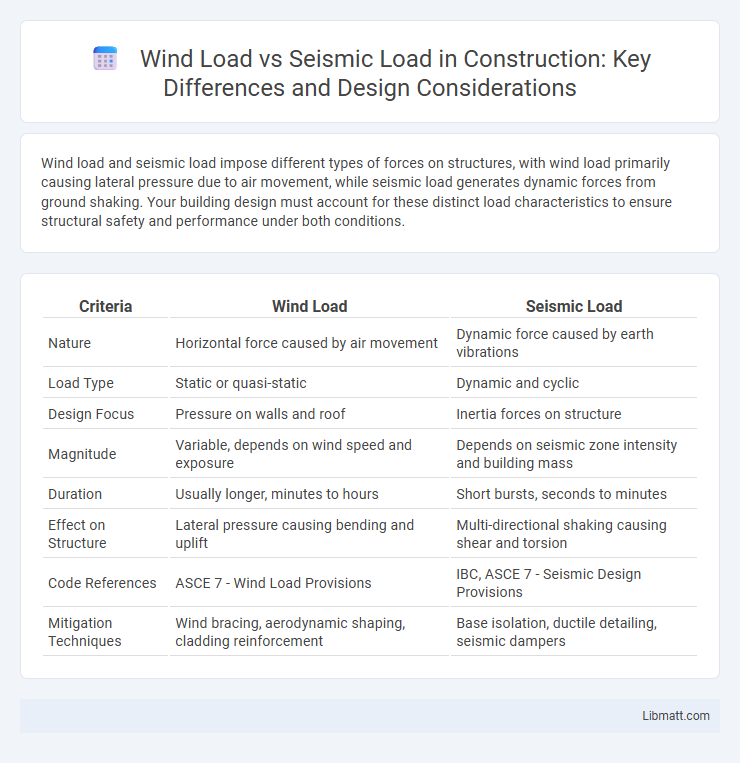Wind load and seismic load impose different types of forces on structures, with wind load primarily causing lateral pressure due to air movement, while seismic load generates dynamic forces from ground shaking. Your building design must account for these distinct load characteristics to ensure structural safety and performance under both conditions.
Table of Comparison
| Criteria | Wind Load | Seismic Load |
|---|---|---|
| Nature | Horizontal force caused by air movement | Dynamic force caused by earth vibrations |
| Load Type | Static or quasi-static | Dynamic and cyclic |
| Design Focus | Pressure on walls and roof | Inertia forces on structure |
| Magnitude | Variable, depends on wind speed and exposure | Depends on seismic zone intensity and building mass |
| Duration | Usually longer, minutes to hours | Short bursts, seconds to minutes |
| Effect on Structure | Lateral pressure causing bending and uplift | Multi-directional shaking causing shear and torsion |
| Code References | ASCE 7 - Wind Load Provisions | IBC, ASCE 7 - Seismic Design Provisions |
| Mitigation Techniques | Wind bracing, aerodynamic shaping, cladding reinforcement | Base isolation, ductile detailing, seismic dampers |
Introduction to Wind Load and Seismic Load
Wind load represents the forces exerted by air movement on structures, varying with wind speed, direction, and building geometry, essential for designing resilient edifices in hurricane-prone or high-wind regions. Seismic load involves ground motion forces generated by earthquake activity, requiring structural designs that accommodate lateral and vertical accelerations to prevent catastrophic failure in seismically active zones. Understanding these distinct dynamic loads guides engineers in implementing appropriate reinforcement, damping systems, and material selections for optimized building safety and performance.
Definitions and Key Concepts
Wind load refers to the force exerted by wind pressure on structures, influenced by factors such as wind speed, direction, and building shape. Seismic load involves the forces generated by earth movements during earthquakes, characterized by ground acceleration and structural vibrations. Both loads require distinct engineering considerations for designing safe and resilient buildings.
Sources and Causes of Wind and Seismic Loads
Wind loads originate from atmospheric pressure variations caused by weather systems, such as storms, cyclones, and gusts, exerting lateral forces on structures. Seismic loads result from the sudden release of energy along fault lines during earthquakes, generating ground motion that induces inertial forces within buildings. Understanding these distinct natural phenomena is crucial for designing structures that resist both wind-induced shear and seismic-induced shaking effectively.
Fundamental Differences Between Wind and Seismic Loads
Wind load acts as a steady or fluctuating surface pressure caused by air movement, primarily exerting horizontal forces on structures. Seismic load results from ground acceleration during earthquakes, inducing complex multidirectional inertial forces affecting the entire structure's mass. Unlike wind load's aerodynamic nature, seismic load involves dynamic ground motion, causing both translation and rotational effects that demand distinct engineering considerations.
Structural Behavior Under Wind and Seismic Forces
Structural behavior under wind load involves lateral forces that induce bending, shear, and overturning moments, requiring designs to prioritize stiffness and aerodynamic shape to minimize vibrations. Seismic load generates multidirectional ground accelerations causing inertial forces that lead to dynamic responses such as base shear and displacement, necessitating ductility and energy dissipation capacity in structures. Your design must integrate these distinct force characteristics to ensure stability and safety against both wind and seismic events.
Load Calculation Methods and Standards
Wind load calculation methods are primarily governed by standards such as ASCE 7 and Eurocode EN 1991-1-4, which use wind speed, exposure categories, and building geometry to estimate pressure distributions. Seismic load calculations follow seismic design codes like ASCE 7 and Eurocode 8, employing response spectrum analysis and time-history analysis to determine base shear and lateral forces based on ground motion data and building dynamic properties. Both approaches require detailed site-specific data and structural parameters to ensure accurate load estimation for safe design.
Design Considerations for Wind Load
Design considerations for wind load emphasize analyzing gust factors, terrain roughness, and building height to determine appropriate lateral force resistance. Structural elements must accommodate dynamic pressure variations using codes such as ASCE 7 or Eurocode EN 1991-1-4, ensuring stability against uplift, overturning, and cladding damage. Wind tunnel testing and computational fluid dynamics (CFD) simulations enhance accuracy in predicting localized pressures and vortex shedding effects on tall or irregular structures.
Design Considerations for Seismic Load
Design considerations for seismic load prioritize the structure's ability to absorb and dissipate energy during earthquakes, emphasizing ductility and flexibility over mere strength. Engineers incorporate base isolation, energy dissipation devices, and careful detailing of joints to prevent brittle failures, ensuring the building can undergo significant lateral displacements without collapsing. Seismic design codes, such as ASCE 7 and Eurocode 8, provide specific criteria for load combinations, importance factors, and response spectra that guide structural analysis and material selection for earthquake resilience.
Code Requirements and Building Regulations
Building codes such as ASCE 7 and Eurocode EN 1990 provide specific criteria for wind load and seismic load calculations, emphasizing different design approaches for lateral forces. Wind load requirements focus on factors like wind speed, exposure category, and building geometry to ensure structural stability under dynamic pressure. Seismic load regulations prioritize ground motion parameters, soil conditions, and building importance to enhance earthquake resistance and occupant safety.
Comparative Analysis: Wind Load vs Seismic Load
Wind load primarily exerts horizontal pressure on structures due to air movement, while seismic load involves dynamic forces generated by ground shaking during an earthquake. Wind load effects are often predictable and steady, allowing for straightforward design considerations, whereas seismic loads are impulsive, multidirectional, and require more complex, performance-based engineering approaches. Understanding these differences helps you optimize structural resilience and safety based on the specific environmental risks of your location.
Wind load vs seismic load Infographic

 libmatt.com
libmatt.com